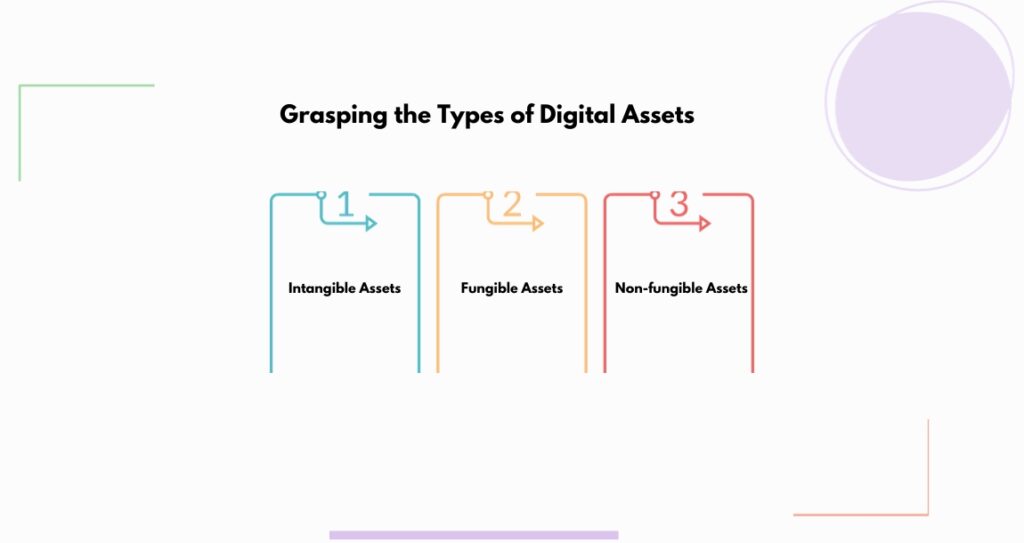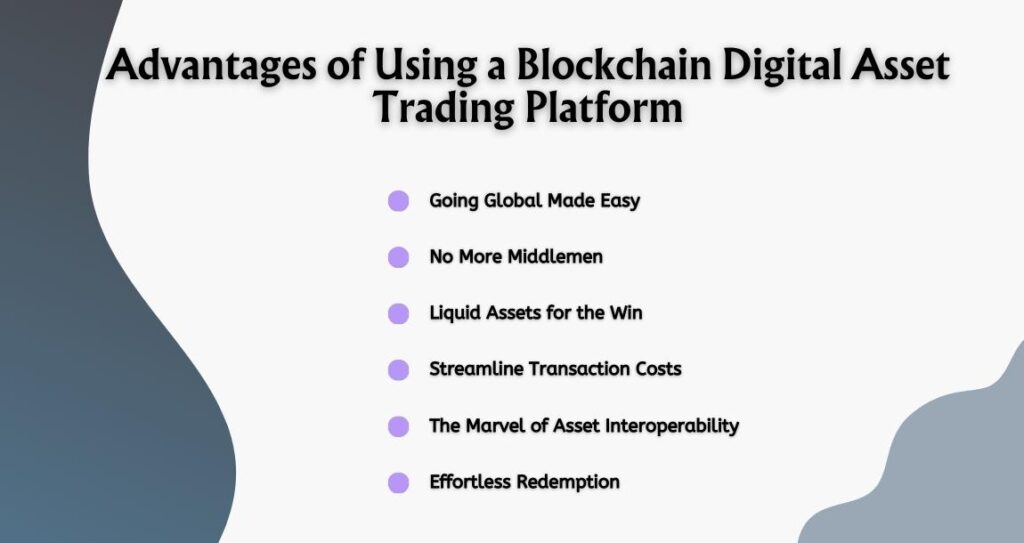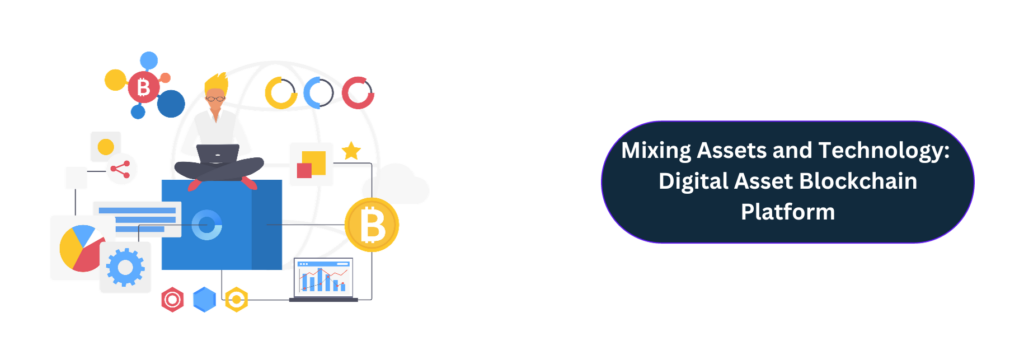In today’s fast-paced digital era, the way we perceive value and ownership is undergoing a transformative shift. Enter the realm of the “digital asset blockchain platform.”
This revolutionary technology has emerged as a game-changer, offering a secure and transparent medium to manage and trade digital assets. Not only does it redefine how assets are exchanged, but it also provides an unparalleled level of authenticity and integrity to the process.
With rapid technological advancements, understanding this platform becomes crucial, especially as it promises to reshape industries and commerce as we know them. Dive with us into this article, as we unravel the intricacies of this groundbreaking innovation.
Contents
- 1 What Are Digital Assets?
- 2 The Drive Behind Digital Asset Conversion
- 3 Digital Assets vs. Regular Files: Spotting the Difference
- 4 Determining the Worth of Digital Assets: Two Key Aspects
- 5 Grasping the Types of Digital Assets
- 6 How Does a Blockchain Digital Asset Trading Platform Function?
- 7 Advantages of Using a Blockchain Digital Asset Trading Platform
- 8 Final Words
- 9 FAQs
- 9.1 1. How does the blockchain ensure the authenticity of a digitized asset?
- 9.2 2. Can digital assets on a blockchain platform be regulated by governments?
- 9.3 3. What happens if a digital asset blockchain platform ceases its operations?
- 9.4 4. How do smart contracts play a role in a digital asset blockchain platform?
- 9.5 5. Are investments in a digital asset blockchain platform safe?
What Are Digital Assets?
In the vast world of digitalization, think of a digital asset as an electronic ownership claim to something of value. Imagine having a special piece of content or a digital representation of a valuable item, right in the electronic space. Essentially, digital assets serve as a modern way to denote value stored in a digital form.
Digital Currencies and Their Audits
Picture the likes of digital money managed by central banks or even familiar platforms like PayPal’s version of USD. These are money, but in electronic form. A catch? There’s a degree of trust involved. Users place their confidence in the managing parties because it’s not always clear how these transactions are authenticated.
Digital Tokens and Their Transparency
Now, enter the world of digital tokens. These are the shining stars of transparency. They give users the power to see their transaction history, maintaining an immutable record. It’s like having a clear trail of where your digital asset has been.
The Drive Behind Digital Asset Conversion
Our world is filled with valuable treasures – real estate, stocks, oil, even metals like gold and silver. Traditionally, these assets have been locked behind layers of paperwork. Think of the last time you wanted to sell a piece of land or maybe buy some stocks. The paperwork can be daunting!
And here’s the catch. Despite all these fancy electronic transaction systems set up by commodity exchanges, they’re not without their burdens. They’re hefty, expensive, and once again, you’re placing trust in third parties.
This is where the power of blockchain digital asset trading platforms steps in. They’re simplifying the game, cutting through the red tape. Financial giants and emerging startups see the potential and are leaning towards the future – a world of tokenized assets.
Digital Tokens as Real-World Asset Representatives
Let’s paint a picture.
Meet Alice, a gold mogul with a whopping $20 million in her vault. Distributing her gold traditionally is a hassle – security concerns, potential frauds, and the entire inspection circus. Now, meet Jane. She’s an enthusiast looking to invest in gold, but she isn’t keen on holding physical bars.
Instead, she wishes to spread her investment across different gold types.
Here’s where blockchain shines. With digital assets blockchain technology, Alice can break down her vast gold reserve into smaller digital tokens. Each token represents a fragment of her gold. Jane can then purchase these tokens, owning parts of various gold types without ever touching a physical bar.
So, when pondering is blockchain a digital platform category? Think of it as the backbone, supporting various types of digital assets, from currencies to tokens.
Digital Assets vs. Regular Files: Spotting the Difference
Picture this: you’re browsing through your computer, and you stumble across numerous files, from photos to documents. Now, how do you determine which of these files is a genuine digital asset? As articulated by Theresa Regli, an authority in the DAM sector, think of digital assets as items with value in their digital format.
To break it down, the essential distinction revolves around the value a particular file holds for an organization.
Real-Life Instances: Understanding Value
Imagine you’ve got a stunning photo from a recent photoshoot. This very image is the centerpiece of your upcoming social media blitz, drawing attention to a soon-to-happen event. Such an image, given its value in terms of outreach and engagement, undoubtedly qualifies as a digital asset.
Conversely, suppose you share a quick screenshot in an email to a prospect. Its value diminishes considerably as it’s a one-time share with no lasting impact. Such files might not earn the title of ‘digital asset’.
Determining the Worth of Digital Assets: Two Key Aspects
The below aspects are the two most fundamental things to determine your digital asset’s worth.
Effort and Time Invested
When assessing an asset’s worth, ponder over the hours, manpower, resources, and strategy channeled into its creation. Generally, assets demanding significant resources often emerge as the most prized ones in an organization’s arsenal.
For instance, misplacing a single photo might be a minor setback, especially with backups or other choices at hand. However, consider the repercussions of losing a meticulously crafted eBook that’s ready for distribution.
Rebuilding it, even with the individual components available, is a formidable task. Shockingly, recent insights from a DAM study highlight that 41% of establishments lacking a robust DAM system have faced such predicaments, forced to reinvent or repurchase assets.
The Irreplaceability Factor
Some assets wear the crown of ‘irreplaceable’. Why? They encapsulate once-in-a-lifetime moments, ones that no amount of time or money can replicate. Dive into the realm of sports marketing to grasp this better.
Envision the euphoria when a soccer player nails the match-winning strike. A snapshot of that singular moment, if lost, is irreplaceable. While its production cost might equate to any of the numerous snaps taken that evening, its emotional and marketing worth is immeasurable.
Grasping the Types of Digital Assets

Mainly there are three types of digital assets and they’re briefly described below —
1. Intangible Assets
Intangible assets are unique because they don’t have a physical form. Think about patents, copyrights, or trademarks. Since they don’t exist physically, blending them with blockchain solutions becomes rather seamless.
However, the tricky part lies in making sure the asset’s transfer on blockchain mirrors its legal transfer. And yes, this might vary from country to country, but generally, tokenizing such assets is simpler because you aren’t wrestling with concerns like shipping or storage.
2. Fungible Assets
When we talk about fungible assets, we refer to those that can swap for a similar one of equal worth. For example, consider gold. One ounce of gold is basically the same as another ounce. However, these assets are often associated with tangible resources, like gold in a vault or oil in a pipeline.
The challenge arises when transferring such assets because of either the logistics or the paperwork involved. This is where blockchain shines. By tokenizing these assets, the need for intermediaries, such as exchange agents or warehouse administrators, gets minimized.
Imagine a world where barrels of oil get traded on a blockchain digital asset trading platform, simplifying the entire process and leaving behind an indisputable digital trail.
3. Non-fungible Assets
Unique items like artwork or specific real estate properties are non-fungible. A prime example is the Mona Lisa painting. It’s one of a kind. And while there are countless digital reproductions, none hold the value or authenticity of the original.
When such unique assets are tokenized on blockchain, it establishes a form of digital ownership or certification that can’t be tampered with.
How Does a Blockchain Digital Asset Trading Platform Function?
Selecting the right blockchain platform and establishing an apt smart contract environment are crucial initial steps. Several blockchain platforms, like TrustToken, Alpha Point, and Fraction/al, facilitate asset digitization.
The process usually involves —
Asset Tokenization
Here, a digital representation of the asset is created, mirroring its physical value. For instance, if digitizing gold, its blockchain value would be pegged to the market rate of actual gold.
Backing Tokens
The digital tokens produced should be equivalent to the real-world assets supporting them. Periodic audits are crucial to verify the tangible holdings against the digital representation.
Regulatory Compliance
Some digital assets, particularly those backed by tangible goods, fall under regulatory oversight. Such assets are termed as “regulatory asset backed tokens”, exclusive to certified investors to ensure legitimacy.
Investor Onboarding
To acquire a fraction of these assets, investors must undergo rigorous KYC/AML verifications. Once cleared, they can join the platform and invest.
Trading and Redemption
These tokens offer liquidity that often surpasses their physical counterparts. Investors can either sell or cash in their digital assets as desired. However, during transfers, an escrow system is typically employed to ensure compliance and security.
Dive into Webisoft’s expertise. Our dedicated Python developers craft exceptional blockchain applications tailored for real-world solutions.
The Distinct Edge of Blockchain in Digital Asset Management
The digital transformation of assets on blockchain comes with multiple advantages. As blockchain simplifies transactions, enables fractional ownership, and reduces overheads, it’s revolutionizing asset management.
In essence, is blockchain a digital platform category? Yes, and it’s one that holds the key to unlocking vast possibilities in the realm of digital asset management.
Advantages of Using a Blockchain Digital Asset Trading Platform

Apart from the technical stuff, you’ll get a whole bunch of advantages from the implementation of digital asset management blockchain. Some of them are —
Going Global Made Easy
In the world of digital assets, there are no borders. Whether you’re sitting in New York or Nairobi, you can delve into the world of digital investments with ease. The digital asset management blockchain offers swift, secure, and hassle-free transactions.
Thus, anyone from anywhere can take part without setting foot outside their home.
No More Middlemen
Why wait for third-party brokers to give you the green light when you can sail smoothly without them? Blockchain platforms ensure that your trades aren’t held up by unnecessary intermediaries, making transactions faster and more cost-effective.
Liquid Assets for the Win
With digital assets blockchain technology, real-world assets become far more liquid. Fractional ownership is now a reality, allowing assets to change hands between entities without getting entangled in legal red tape.
Streamline Transaction Costs
Imagine making transactions without the hefty fees. Sounds good, right? Blockchain does away with those pesky middlemen, slashing transaction costs significantly. Plus, incorporating compliance measures directly into the platform’s smart contracts ensures that the tokens are traded legally, further enhancing efficiency.
The Marvel of Asset Interoperability
Interoperability isn’t just a buzzword; it’s one of the pillars of digital asset blockchain platforms. A blockchain platform, particularly one based on standards such as ERC-721 or ERC-20, provides a harmonized way to handle varied value forms.
Effortless Redemption
Let’s paint a picture: You’ve bought tokens, each mirroring the value of 2 grams of gold. Fancy switching them for actual gold or cash? It’s simpler than you think. With a blockchain digital asset trading platform, you can trade your tokens for the real deal.
Want cash? The equivalent amount can swiftly flow into your linked wallet post-sale. Craving physical gold? It’s yours, albeit with a small shipping charge.
Final Words
It’s evident that the blockchain digital asset trading platform stands as a beacon of innovation as we journeyed through the intricate world of digital assets. This technology provides not just a secure channel for transactions but also ushers in a new era of transparency and trust.
For individuals and businesses alike, embracing and understanding this platform is no longer an option, but a forward-looking strategy. As we look to the future, it’s clear that blockchain’s influence will only continue to grow, shaping a new horizon for the digital realm.
Venturing into blockchain development? Let Webisoft be your guide. Tailored solutions, expert insights, and a journey crafted just for you. Discover blockchain brilliance with Webisoft.
FAQs
1. How does the blockchain ensure the authenticity of a digitized asset?
Blockchain technology uses a decentralized and immutable ledger system. When an asset is digitized, its details and ownership are recorded on this ledger. Every subsequent transaction or change related to this asset is added to the chain of records. Data is distributed across multiple nodes and cannot be altered without consensus, which ensures the authenticity of the asset.
2. Can digital assets on a blockchain platform be regulated by governments?
Yes, governments can regulate digital assets, even if they are on a decentralized platform. Even though blockchain provides a decentralized and global trading platform, digital assets and the platforms themselves can still be subject to regional regulations, such as taxation.
3. What happens if a digital asset blockchain platform ceases its operations?
The beauty of blockchain is its decentralized nature. Even if a specific platform ceases operations, the digital assets and their transaction records remain intact on the blockchain. However, the utility or value of specific platform-dependent tokens might be affected.
It’s crucial to ensure backups and consider the interoperability of digital assets to safeguard investments.
4. How do smart contracts play a role in a digital asset blockchain platform?
Smart contracts are self-executing contracts where the agreement terms are written directly into code lines. Blockchain platforms automate and streamline processes, such as asset trading, ensuring specific conditions are met before transactions proceed. This automation not only makes transactions more efficient but also reduces the risk of human errors or manipulation.
5. Are investments in a digital asset blockchain platform safe?
Although blockchains are immutable and decentralized, their security is also determined by governance, regulatory compliance, and technology infrastructure. Potential investors should conduct thorough research and, if possible, consult financial advisors before diving into any digital asset investments.
